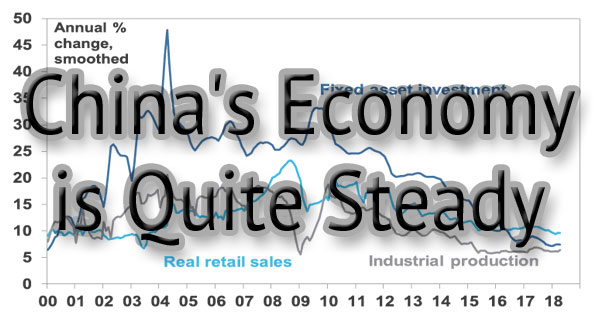What about high debt levels and other dangers?
Key points
– Main dangers concerning China associate with the policy concentration moving to decreasing leverage and reform, fast financial debt expansion, a trade battle with the United States and the real estate cycle.
– Steady and firm Chinese growth is complementary of commodity costs and is favorable for the Australian economic climate and resource shares.
– Chinese economical progress has been consistent from at about 6.8%. Anticipate Chinese financial growth this year of approximately 6.5% and rising cost of living of 2.5-3%.
– Chinese shares continue to be moderately valued from a long-term viewpoint.
Introduction
It appears there is constant hand wringing about the dangers around the Chinese economy with the typical issues being around out of balance development, financial obligation, the residential or commercial property market, the currency exchange rate and capital circulations and a “difficult landing”. This angst is easy to understand to some degree.
Fast development as China has actually seen brings concerns about its sustainability. And China is now the world’s second biggest economy, its most significant factor to development and Australia’s most significant export market so exactly what takes place in China has huge implications worldwide. However regardless of all the concerns it keeps continuing and just recently development has actually been fairly steady. This note takes a look at China’s development outlook, the primary dangers and exactly what it implies for financiers and Australia.
Benign Inflation with Stable growth
Chinese development slowed through the very first half of this years culminating in a development and currency scare in 2015 which saw Chinese policy swing from moderate tightening up to stimulus. This has actually seen quite steady development considering that 2016 of around 6.8% year on year. Constant with this, company conditions PMIs have actually likewise been steady (see the next chart) and unpredictability around the Renminbi has actually fallen & capital outflows have actually slowed.
Chinese growth is holding steady

Source: Bloomberg, AMP Capital
April information saw commercial production and earnings speed up however financial investment and retail sales slow a bit. Electrical energy usage, train freight and excavator sales have actually lost momentum from their highs. However the general impression is that development is still strong.
Chinese activity indicators

Source: Thomson Reuters, AMP Capital
While there is a requirement for China to rebalance its development away from investing for exports, the downturn in financial investment development to beneath that for retail sales, imports growing quicker than exports and the shrinking in China’s bank account deficit from 10% of GDP to 1% of GDP recommends this taking place.
On the other hand, inflation in China is benign with manufacturer cost inflation around 3% and customer rate inflation around 2%.
Chinese deflation has ended, but inflation is benign

Source: Bloomberg, AMP Capital
Policy neutral
Chinese financial policy has actually been fairly steady just recently. There has actually been some talk of improving domestic need and bank needed reserve ratios have actually been cut. However the latter appears to have actually been to enable banks to pay back medium term loan centres, rates of interest have actually been steady and development in public costs has actually been constant at 7-8% year for the year.
Growth and inflation outlook
We anticipate Chinese development this year to slow a bit as financial investment slows even more to around 6.5% and customer inflation of 2-3%.
Key risks facing China
There are 4 crucial threats dealing with China.
Initially, the policy focus might move from preserving strong development to accelerating medium-term financial reforms and deleveraging (or cutting financial obligation ratios) that might threaten short-term financial development. Some anticipated this to happen after the 19th National Congress of the Communist Celebration ran out the method late in 2015. And the elimination of term limitations on President Xi Jinping might probably make him less conscious a short-term financial decline. Nevertheless, up until now there is no indication of this and the authorities appear concentrated on preserving strong development.
Second, China’s quick financial obligation development might turn sour. Given That the Global Financial Crisis, China’s ratio of non-financial financial obligation to GDP has actually increased from around 150% to around 260%, which is a much faster increase than has actually happened in all other significant nations.
Chinese non-financial debt

Source: BIS, RBA, AMP Capital
This has actually been focused in business financial obligation and to a lower degree home financial obligation and has actually been simplified by monetary liberalisation and a great deal of the development has actually been outside the more regulated banking system in “shadow banking”. An apparent issue is that when financial obligation development is quick it leads to a great deal of financing that ought to not have actually occurred that ultimately goes bad. Nevertheless, China’s financial obligation issues are various to a lot of nations. Initially, as the world’s greatest financial institution country China has actually obtained from itself – so there’s no foreigners to trigger a a foreign exchange crisis.
2nd, much of the increase in financial obligation owes to business financial obligation that’s partially linked to fiscal policy therefore the chances of federal government bailout are high.
Lastly, the crucial driver of the increase in financial obligation in China is that it conserves around 46% of GDP and much of this is recycled through the banks where it’s called debt. So unlike other nations with financial obligation issues China has to conserve less and take in more and it has to change more of its conserving into equity instead of debt. Chinese authorities have actually long understood the concern and development in shadow banking and general financial obligation has actually slowed however knocking on the financial obligation brakes without seeing more powerful usage makes no sense.
Third, the danger of a trade war has actually intensified with Trump threatening tariffs on $50-150bn of imports from China and limitations on Chinese financial investment in the United States and China threatening to reciprocate. While “useful” settlements have actually begun and have actually seen China devote to purchasing more from the United States & to reinforce laws safeguarding copyright which saw the United States at first delay the tariffs and limitations, Trump has actually shown that they will be implemented this month which seems targeted at prodding China to move quickly (and calming his base). Eventually, we anticipate a worked out service, however the dangers are high and a full-blown trade war with the United States might knock 0.5% approximately off Chinese short-term development.
Lastly, with the Chinese home market slowing once again there is naturally the threat that this might develop into a slump. It deserves a watchful eye however, missing an external shock looks uncertain. The “ghost cities” fear of a couple of years earlier– it initially aired on SBS TELEVISION back in 2011 – has plainly not come to much. It’s uncertain China ever truly had a generalised real estate bubble: family financial obligation is low by innovative national requirements; home costs have not stayed up to date with earnings; and while there’s been some extreme supply, this isn’t so in first tier cities; and the quality of the real estate stock is low requiring replacement. So, I believe the home crash worries continue to be overstated and the current bout of weak points in costs seems simply another cyclical downswing in China which there have actually been a number of over the last 10 years.
Chinese residential property prices – another cyclical downswing

Source: Bloomberg, AMP Capital
Our assessment remains that these risks are manageable, albeit the trade war risk is the hardest for China to manage given the erratic actions of President Trump. The Chinese Government has plenty of firepower to support growth though, so a “hard landing” for Chinese growth remains unlikely for now.
The Chinese share market
Considering its low in January 2016 the Chinese share market has actually had a great recovery. However Chinese shares are trading on a cost to revenues ratio of 12.8 times which is far from extreme.
Chinese Shares Stay Inexpensive

Source: Thomson Reuters, AMP Capital
With valuations okay and growth continuing, Chinese shares should provide reasonable returns, albeit they can be volatile.
Implications for Australia – not yet 2003, but still good
Solid growth in China should help keep commodity prices, Australia’s terms of trade and export volume growth reasonably solid. This, along with rising non-mining investment and strong public investment in infrastructure, will offset slowing housing investment and uncertainty over the outlook for consumer spending and will keep Australian economic growth going. However, with strong resources supply (and still falling mining investment) we are a long way from the boom time conditions of last decade and growth is likely to average around 2.5-3%. Rising US interest rates against flat Australian rates suggests more downside for the $A, but solid commodity prices should provide a floor for the $A in the high $US0.60s.
Key implications for investors
- Chinese shares remain reasonably good value from a long-term perspective, but beware their short-term volatility.
- Solid Chinese growth should support commodity prices and resources shares.
 Contact Brad Lonergan (Financial Planner Newcastle and Lake Macquarie) for more information on how China’s Economy can affect us here in Newcastle and Lake Macquarie.
Contact Brad Lonergan (Financial Planner Newcastle and Lake Macquarie) for more information on how China’s Economy can affect us here in Newcastle and Lake Macquarie.
Call 0423 621 120 or email brad@bmkfs.com.au







